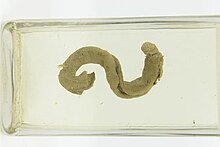| Balanoglossus gigas | |
|---|---|

| |
| Scientific classification | |
| Domain: | Eukaryota |
| Kingdom: | Animalia |
| Phylum: | Hemichordata |
| Class: | Enteropneusta |
| Order: | Enteropneusta |
| Family: | Ptychoderidae |
| Genus: | Balanoglossus |
| Species: | B. gigas |
| Binomial name | |
| Balanoglossus gigas (Müller in Spengel, 1893) | |
| Synonyms | |
| |
Balanoglossus gigas is a species of large free-living enteropneust (acorn worm) found in the Atlantic Ocean. It is the largest acorn worm currently known, and has a strong iodoform-like odour. It is bioluminescent.
Description
Size
Balanoglossus gigas is recorded as growing to 1.5 metres (4.9 ft) in length, and is thus considered the largest acorn worm currently known. One specimen from the Brazilian coast was recorded as measuring 1.8 metres in length.
Chemical accumulations
When handled, B. gigas releases thick, sticky mucus with a strong smell of iodoform, which may serve as a deterrent to predators. The odour is caused by 2,6-dibromophenol, a phenol also reported from crustaceans, where it is the cause of a similar odour.
Balanglossus gigas also has accumulation of iodine throughout its body, something reported from no other acorn worm or protochordate. The iodine concentration is highest in the hepatic (liver) region, and lowest in the proboscis. Other compounds were also found to be present in accumulations in the body of B. gigas: high concentrations of calcium were found in the skeleton, while phosphate was found in the proboscis, copper in the collar and the skeleton, chloride in the collar and branchial area, iron in the hepatic region, nitrogen in the genital and hepatic regions, and a mix of sodium, calcium, potassium and magnesium found at both the front and back of the body.
Bioluminescence
A multipart study in the 1960s assessed the bioluminescence of Balanoglossus biminiensis, since synonymized with B. gigas. The reaction causing bioluminescence incorporates hydrogen peroxide and a luciferin common to balanglossids.
Distribution and habitat
Balanoglossus gigas are found off the coasts of the U.S. state of Georgia, Brazil, Cuba, and in the Gulf of Mexico. Like most acorn worms, B. gigas specimens prefer somewhat sheltered habitats with surface layers of fine sand lying above layers of fine to coarse gravel. They live in burrows with thin mucous lining on the sea floor. The burrows typically measure less than 2 cm in width and beyond 2 meters in length.
References
- ^ Swalla, B.J.; van der Land, J. (2023). "Balanoglossus gigas (Müller in Spengel, 1893)". Hemichordata World Database. Retrieved 2023-04-19.
- Tassia, Michael G.; Cannon, Johanna T.; Konikoff, Charlotte E.; Shenkar, Noa; Halanych, Kenneth M.; Swalla, Billie J. (2016-10-04). Hejnol, Andreas (ed.). "The Global Diversity of Hemichordata". PLOS ONE. 11 (10): e0162564. Bibcode:2016PLoSO..1162564T. doi:10.1371/journal.pone.0162564. PMC 5049775. PMID 27701429. S2CID 3920242.
- Godeaux, Jean E.A. (24 April 2014), Florkin, Marcel; Scheer, Bradley T. (eds.), "Introduction to the Morphology, Phylogenesis, and Systematics of the Lower Deuterostomia", Chemical Zoology, vol. 8, Elsevier Science, ISBN 9780323163347
- ^ Sawaya, Paulo (5 May 1951). "Balanoglossus gigas Fr. Müller rediscovered on the Brazilian Coast". Nature. 167 (4253): 730–731. Bibcode:1951Natur.167R.730S. doi:10.1038/167730b0. ISSN 1476-4687. PMID 14899495. S2CID 2116403.
- Felder, Darryl L.; Camp, David K. (2009). Gulf of Mexico Origin, Waters, and Biota: Biodiversity. Texas A&M University Press. ISBN 978-1-60344-269-5.
- Sawaya, Paulo (Jun 1950). "Re-finding of Balanoglossus gigas FR. MULLER on the brasilian sea shore". Boletim do Instituto Paulista de Oceanografia (in Portuguese and English): 135–138. doi:10.1590/S0100-42391950000100009. S2CID 194068993.
- ^ Burdon-Jones, C. (1962). "The Feeding Mechanism of Balanoglossus gigas". Marine Science Laboratories, Univ. Of Wales. 24 (24): 255. doi:10.11606/issn.2526-3382.bffclzoologia.1962.120589.
- PubChem. "2,6-Dibromophenol". pubchem.ncbi.nlm.nih.gov. Retrieved 2023-04-22.
- Ashworth, R. B.; Cormier, M. J. (1967-03-24). "Isolation of 2,6-dibromophenol from the marine hemichordate, Balanoglossus biminiensis". Science. 155 (3769): 1558–1559. Bibcode:1967Sci...155.1558A. doi:10.1126/science.155.3769.1558. ISSN 0036-8075. PMID 6020478. S2CID 24002705.
- Whitfield, Frank B; Last, John H; Shaw, Kevin J; Tindale, C Ross (1988). "2,6-Dibromophenol: The cause of an iodoform-like off-flavour in some Australian crustacea". Journal of the Science of Food and Agriculture. 46 (1): 29–42. Bibcode:1988JSFA...46...29W. doi:10.1002/jsfa.2740460104.
- De Jorge, F. B.; Sawaya, Paulo; Petersen, J. A.; Ditadi, A. S. F. (1965-11-26). "Iodine: Accumulation by Balanoglossus gigas". Science. 150 (3700): 1182–1183. Bibcode:1965Sci...150.1182D. doi:10.1126/science.150.3700.1182. ISSN 0036-8075. PMID 17742599. S2CID 42864502.
- ^ De Jorge, F. B.; Petersen, J. A.; Sawaya, P. (1967-08-01). "Biochemical studies on the enteropneust Balanoglossus gigas (Fr. Muller, 1898)". Comparative Biochemistry and Physiology. 22 (2): 467–475. doi:10.1016/0010-406X(67)90609-3. ISSN 0010-406X. PMID 6075145.
- Dure, Leon S.; Cormier, Milton J. (February 1963). "Studies on the Bioluminescence of Balanoglossus biminiensis extracts". The Journal of Biological Chemistry. 238 (2): 790–793. doi:10.1016/S0021-9258(18)81336-9.
- A. Sydney Johnson, Hilburn O. Hillestad (1974). An Ecological Survey of the Coastal Region of Georgia.
- "Balanoglossus gigas (Müller in Spengel, 1893) - Ocean Biodiversity Information System". obis.org. Retrieved 2023-04-21.
| Taxon identifiers | |
|---|---|
| Balanoglossus gigas | |